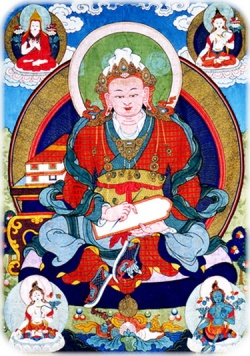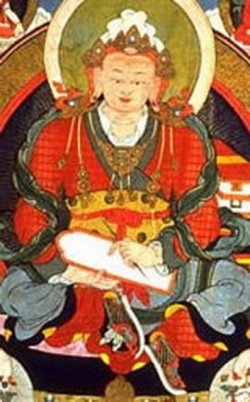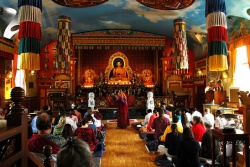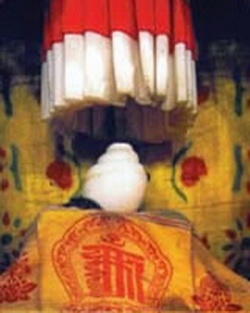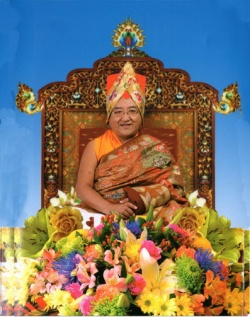Sakya Trizin
Sakya Trizin (Tibetan: ས་སྐྱ་ཁྲི་འཛིན།, ZYPY: Sa'gya Chizin, literally "Sakya Throne Holder"; Chinese: 萨迦法王 or 萨迦崔津) or Sa'gya Gongma Rinboqê (གོང་མ་རིན་པོ་ཆེ།) is the traditional title of the head of the Sakya Order of Tibetan Buddhism.
His Holiness Sakya Trizin is the supreme head of the Sakya Tradition of Tibetan Buddhism.
Brief
He was born on the seventh of September, 1947 in Tsedong, Tibet.
Presently His Holiness resides at the Sakya Dolma Phodrang, Rajpur, Dehradun and also travels around the world to turn the wheel of Dharma.
Extensive
A short biography
The Khön family, to which His Holiness Sakya Trizin belongs, has a long history that extends back more than 1400(?????) years to pre-Buddhist Tibet.
The Sakya Khön family’s ancestors were “The Gods of the Realm of Clear Light” and so the family was known as Lha-Rig or “The Celestial Race”.
Later, when they subjugated the Rakshas, they were called The Immaculate “Khön Gyi Dhung” or “The Family of Conquerors”.
In the later eleventh century when they established the Sakyapa Order of Tibetan Buddhism, they were called “The Sakyapa Lineage”.
In more recent times they became known as “The Dolma Phodrang” or “The Tara Palace Lineage”, as their palace was next to the Turquoise Tara Shrine at the Sakya monastery in Tibet.
From the advent of the Khön race until now, many famous masters have appeared without interruption in this illustrious lineage, including the five great founders of the Sakyapa Order.
Vajradhara Ngawang Conga Rinchen, the previous pphead of the Sakya]] Dolma Phodrang, and Sonam Drolkar, the sister of a renowned minister of the Tibetan government had four children together.
The eldest, a daughter whose name is Jetsun Chime Thrinley was born in 1938 and currently lives and teaches in Canada. The next born were a son and daughter who both passed away in infancy.
Their youngest son, the present Sakya Trizin, was born in the Sixteenth Rabjung* in the year of The Wood Bird on the first day of the eight-month which is September 7th, 1945. He was born at the Sakya Palace of Tsedong.
Immediately after his birth, profound rituals were performed to increase his wisdom, including tracing the letter “Dhih” on his tongue. Many auspicious signs occurred on the day of his birth.
A rainbow tent appeared above the palace and milk collected from one hundred different Dris (female yaks) were offered to the palace as well as a statue of Guru Padmasambhava.
While he was an infant, his name was Ayu Vajra.
Later, when his father gave him his first major initiation of “The Nine Deities of Amitayus”, he was given his present name Ngawang Kunga Thegchen Palber Thrinley Samphel Wangyi Gyalpo.
When the family returned to the main Sakya monastery the next year there was an extensive celebration of the anniversary of his birth. He received the major initiation of Vajra Kilaya and many other profound teachings from his father.
Both parents died while His Holiness was still young so his maternal aunt, Thrinley Paljor Sangmo, with great kindness, took extremely good care of him.
She appointed Jamphel Ponlop Kunga Gyaltsen as his first tutor and from him he learned the fundamental of the Tibetan reading, writing, memorization and the recitation of basic prayers.
He learned chanting, music, ritual dancing, mudras and other subjects from his junior tutor Kunga Tsewang.
After completion of these studies, a great celebration was held in which the Sakya Trizin officially entered both the Mahayana and Vajrayana monasteries to perform the traditional Sakya ceremonies.
When His Holiness finished his studies at the Sakya Monasteries, he went to receive teachings at the Ngor E-Wam monastery.
There, at the age of five, he received “The Common and Uncommon Lamdre” and many other profound teachings, bestowed upon him by his main root guru the great Ngor abbot, Vajradhara Ngawang Lodroe Zhenphen Nyingpo.
In 1951 the Sakya Trizin made a pilgrimage to Lhasa.
There, at the age of six, he was designated the throne holder of the Sakya Order by His Holiness the Dalai Lama.
Accordingly, the next year a preliminary enthronement ceremony was performed in which he accepted the official seals of the office of the Sakya Trizin.
The following year from Ngawang Zhenphen Nyingpo’s regent, Ngawang Tenzin Nyingpo, His Holiness received the initiation and reading transmission of “The Collection of Dharanas”.
From Lama Ngawang Lodroe Rinpoche, he received the initiations and profound oral instructions of the Three Red Deities, Three Vajra Yoginis and the two main Protectors of the Sakya Order.
At the age of eleven he made another pilgrimage to Lhasa during which he received Dharma instructions in the Potala from His Holiness the Dalai Lama. There, before a large audience, he gave an extensive explanation of the Mandala offering due to which his wisdom came to be proclaimed throughout Tibet.
During this period, from Jamyang Khyentse Chokyi Lodro, he received many tantric initiations and teachings according to the Sakya tradition as well as the teachings and initiations of the Dzogchen Lineage.
In 1957, he received the Lamdre again, this time from the great abbot Vajradhara Jamphel Sangpo, according to the tradition of the Khön Lineage Transmission.
In 1959, at the age of fourteen, he was formally enthroned as the Sakya Trizin, beginning with a seven day Mahakala ritual followed by an elaborate three day enthronement ceremony during which representatives of His Holiness the Dalai Lama and the Tibetan Government were in attendance.
Later that year, due to change in the political situation of Tibet, His Holiness along with some of his attendants moved to India.
The next year, His Holiness established the Ghoom Monastery in Darjeeling and Sa-Ngor Choetsog in Gangtok and thus began his task of reassembling the Sangha.
On many different occasions in Tibet, as well as in India, His Holiness received extensive philosophical teaching in Logic, Abhidharma, Prajna Paramita and The Clarification of the Three Vows from many great scholars like the abbots Dosep Thupten, Tritso Rinchen and Serjong Appey.
From the last of them, he also received a thorough and detailed explanation of The Hevajra Root Tantra and many related teachings.
From one of the four Ngor abbots, Phendhe Khen Rinpoche, he received the initiation and explanation of The Yamantaka in the Ra Lotsawa tradition as well as The Collected Writings of Ngorchen Konchog Lhundrub.
In 1964, He undertook the task of reestablishing the main seat of Sakya Order in Rajpur, Uttar Pradesh, India.
In 1968 in order to benefit the lay followers of the Sakya Order, he established the Tibetan settlement in Puruwala in Himachal Pradesh, India.
During the years 1971 and 72, he received the initiations from “The Collection of All Tantras”, “The Collected Writing of Ngorchen Kunga Sangpo”, “The Uncommon Lamdre from the Tsarpa Tradition” and “The One Hundred Teachings of the Jonang Tradition” from Chogye Trichen Rinpoche, Ngawang Khyenrab Legshey Gyatso.
In 1974, to maintain the unbroken lineage of Khön family, His Holiness married Dagmo Kusho Tashi Lhakyi, the daughter of a minister of the king of Derge.
That year was highlighted by the auspicious birth of their elder son Ratna Vajra Rinpoche.
In 1978, he received the complete reading transmission of “The Collected Works of the Five Great Founders of Sakyapa Tradition” and “The Collected Tantric Works of the Omniscient Teacher Gorampa” from the Lord of Refuge Dezhung Rinpoche.
In 1979, his younger son Gyana Vajra Rinpoche was born.
The following Year, His Holiness performed the opening ceremony of the main Sakya Monastery Thupten Namgyal Ling in Puruwala, Himachal Pradesh.
In order to promote higher education and extensive philosophical training and to maintain the living transmission of the Sakyapa teachings and commentaries, His Holiness requested his own tutor, the most venerable Khenpo Appey Rinpoche, to establish the Sakya College and to be the Dean of the college.
Through his hard work and vast wisdom, the Sakya College was established in 1972.
Since then, the college has produced monks with exceptional scholastic virtues and caliber who had come from various monasteries.
At the college they received high quality and in depth instructions in Tantra, Sutra and other common subjects.
After graduation, they have returned to their respective monasteries or, as assigned by His Holiness, to serve in various capacities within the Sakya Order.
Thus, they have contributed greatly to the spread of this glorious tradition all over the world and benefited many sentient beings.
Through establishment of the Sakya College, His Holiness has revitalized both the sutric and tantric traditions of the Tibetan Buddhism and ensured the continuity of a new generation of well trained teachers and practitioners.
Until now, His Holiness has performed major and minor retreats of twenty deities of the Sakya Lineage.
From a very young age he has undertaken many retreats and has given many initiations such as “The Upper and The Lower Initiations of Vajrakilaya”.
Since his arrival in India, he has given “The Common Lamdre” on four occasions and “The Uncommon Lamdre” once.
In addition, he was bestowed “The Common Lamdre” four times and “The Uncommon Lamdre” twice overseas.
Therefore in total he has given “Lamdre” eleven times and “The Collection of Sadhanas” thrice and has bestowed many initiations on “The Collection of Tantras”.
For the benefit of those who wish to study Lord Buddha’s doctrine, His Holiness has turned the wheel of Dharma all over the world.
So far, he has given teachings in America, Australia, Canada, England, Estonia, France, Germany, Hungary, Hong Kong, India, Indonesia, Italy, Japan, Malaysia, Monaco, Mongolia, Nepal, New Zealand, Russia, Singapore, Spain, Sweden, Switzerland and Thailand.
To all of his fortunate disciples, he has extended his infinite compassion and wisdom.
This is evident in the books he has written. Until the present day, he has written two volumes containing the detailed list of all the teachings he has received from various masters and another volume enumerating the works of the great masters of the Sakyapa Order.
He has also written an autobiography of two volumes and another in a brief version.
He has written profoundly upon the Birwapa’s “Guru Yoga Puja” and many other ritual texts and composed dedication prayers as well as many other short verses.
To preserve an unbroken lineage of teachings and the tradition of the Khön family, he has ensured that his two sons are receiving an extensive education of the Buddhadharma.
In short, His Holiness Sakya Trizin upholds the entire Buddhist doctrines and has spread it far and wide throughout the world. He has been an unfailing source of wisdom and compassion for all of his Dharma students.
Most of the time when he is not on a teaching tour and when he is not engaged in other religious commitments, he lives in Rajpur, Dehradun, at the Sakya Dolma Phodrang, and extends his infinite compassion and blessings to a stream of devotee everyday.
His Holiness Sakya Trizin (Ngawang Kunga Tekchen Palbar Sampel Wangi Gyalpo) Tib. ས་སྐྱ་ཁྲི་འཛིན་, sa skya khri 'dzin, (b. September 7th 1945, 1st day of the 8th lunar month of the Wood Bird year) (called by Tibetans ས་སྐྱ་གོང་མ་རིན་པོ་ཆེ་, Wyl. sa skya gong ma rin po che) is the revered throne holder of the Sakya order of Tibetan Buddhism.
He is the 41st patriarch of the Khön lineage which dates back to 1073.
He is renowned as an emanation of both Manjushri and Mahasiddha Virupa, the founder of the Lamdré teachings, and also as an incarnation of Apang Tertön.
He is a brilliant master who manifests profound wisdom and compassion, and his excellent command of English render his teachings particularly beneficial to western students.
He was born in 1945 in Tibet and escaped with his family to India in 1959 where he continues to live and rebuild both the lay and monastic elements of the Sakya tradition.
He has guided the establishment of over thirty monasteries in India and Nepal and has helped found Sakya centres around the world.
His elder sister is Jetsün Kushok Chimey Luding.
He has two sons, Khonrig Ratna Vajra Sakya and Khondung Gyana Vajra Rinpoche.
Teachings & Empowerments Given to the Rigpa Sangha
- 15 August-3 September 1978, Dzogchen Orgyen Chöling, London, UK—teaches on Mahayana and Vajrayana in the context of Lamdré.
Gives Manjushri, Vajravarahi, Hevajra, Chenrezik from Thangtong Gyalpo & Vajrakilaya from Jamyang Khyentse Chökyi Lodrö empowerments.
- October 1984—spends eight days at the London Rigpa centre; gives the empowerments of Manjushri and Vajrakilaya and teaches on 'The Triple Vision', 'The Teaching of Buddha in Everyday Life' and the 'Nature of Mind'.
- 28-30 March 1989—teaches at Cornwall retreat, UK; gives Vajrakilaya & Manjushri empowerments.
- 3-4 April 1989—teachings in Paris.
- October 1991—gives the Khön family lineage empowerment of Vajrakilaya in the London centre. His monks perform the sacred dances associated with the ritual at the Shaw Theatre.
- May 1995—H.H. Sakya Trizin and Jetsün Kushok Chimey Luding visit Rigpa London. Teachings on Parting from the Four Attachments are given. 21 May, H.H. Sakya Trizin gives a Vajrakilaya empowerment.
- 14-15 September 1996, Paris, Salle Adyar, 'The Healing Power of the Mind' event—teaches on healing in the context of the Four Noble Truths and gives a Vajrasattva empowerment.
- 28-29 September 1996, Lerab Ling, 'Wisdom and Compassion' event—teachings on the heart and essence of the Mahayana, and gives Chenrezik and Manjushri empowerments.
- 3-4 June 2000, London Rigpa—gives an empowerment.
- 22-23 June 2007, Lerab Ling—gives Khön family lineage empowerment of Vajrakilaya.
- 3 September 2011, Lerab Ling, Chimé Pakmé Nyingtik and Thangyal Tsédrup long-life empowerments
Publications
- His Holiness Sakya Trizin, Freeing the Heart and Mind—Introduction to the Buddhist Path: Part 1, Wisdom Publications
Further Reading
- Sandra Penny-Dimri,'The Lineage of His Holiness Sakya Trizin Ngawang Kunga' in The Tibet Journal, Vol.20 No.4 Winter 1995
Internal Links
- Prayer for the Long Life of His Holiness Sakya Trizin
- Three Wisdoms—An Interview with H.H. Sakya Trizin
- Throneholders of the Sakya school
External Links
- H.H. Sakya Trizin's Official website
- Longer Biography
- Video of the visit of His Holiness Sakya Trizin to Lerab Ling in June 2007
The Sakya Order of Tibetan Buddhism was founded in 1073, when Khon Konchog Gyalpo (a.k.a. Kön Gönqog Gyäbo), a member of Tibet’s noble Khön (Koin) family, established a monastery in the region of Sakya, Tibet, which became the headquarters of the Sakya Order of Tibetan Buddhism.
Since that time, the leadership of the Sakya Order has descended within the Khön family.
Current Sakya Trizin
The current Sakya Trizin is the 41st Sakya Trizin.
His legal name is "Sakya Trizin" and he is referred to as His Holiness Sakya Trizin.
His religious name is Ngawang Kunga Tegchen Palbar Trinley Samphel Wangyi Gyalpo. H.H. Sakya Trizin is considered second only to His Holiness the Dalai Lama in the spiritual hierarchy of Tibetan Buddhism.
Sakya Trizin was born on September 7, 1945 in Tsedong, near Shigatse, Tibet.
From his father, Vajradhara Ngawang Kunga Rinchen, he received important initiations and teachings in the Sakya lineage.
He began intensive religious study at the age of five. In 1952, he was officially designated as the next Sakya Trizin by His Holiness the Fourteenth Dalai Lama.
He continued intensive training from his main teacher Ngawang Lodroe Shenpen Nyingpo and many other famous Tibetan scholars, studying extensively in both the esoteric and exoteric Buddhist traditions.
In 1959, at the age of fourteen, he was formally enthroned as head of the Sakya Order of Tibetan Buddhism.
In the same year, due to the political situation in Tibet, the Sakya Trizin, his family, and many lamas and monks from the Sakya Monastery relocated to India.
To maintain the unbroken lineage of the Khon family, in 1974 Sakya Trizin consented to requests that he accept Tashi Lhakee, daughter of a noble family from Dege in Kham as his consort.
In the same year his first son, H.E.Khondung Ratna Vajra Rinpoche, was born. In 1979, a second son, H.E.Khondung Gyana Vajra Rinpoche was born.
After leaving Tibet, in 1963, the Sakya Trizin re-established the seat of the Sakya Order in Rajpur, India, building a monastery known as Sakya Centre.
Since that time, he has worked tirelessly to preserve the thousand-year-old religious heritage of the Sakya Order and to transmit its teachings to succeeding generations.
He founded and directly guides a number of institutions, including Sakya Monastery in Rajpur, Sakya Institute, Sakya College, Sakya Nunnery, Sakya College for Nuns, Sakya Tibetan Settlement, Sakya Hospital, dozens of other monasteries in Tibet, Nepal, and India, and numerous Dharma Centers in many countries.
Sakya Trizin is a highly accomplished Buddhist master respected by all four schools of Tibetan Buddhism and teaches widely throughout the world.
He has bestowed the extensive Lam Dre teaching cycle, which is the most important teaching of the Sakya Order over 18 times on various continents,
and also transmitted major initiation cycles such as Collection of All the Tantras, and the Collection of all the Sadhanas, which contain almost all of the empowerments for the esoteric practices of the various schools of Tibetan Buddhism to hundreds of lineage holders in the next generation of Buddhist teachers.
He has trained both of his sons, Khonrig Ratna Vajra Sakya and Khonrig Gyana Vajra Sakya as highly accomplished Buddhist masters, and they both travel widely, teaching Buddhism throughout the world.
The year 2009 marked the fiftieth anniversary of Sakya Trizin’s headship of the Sakya Order.
The occasion was celebrated as a Golden Jubilee with extensive celebrations and tributes to his success in preserving and maintaining the Sakya Order of Tibetan Buddhism.
Sakya Trizin lineage
- According to legend Ciring descended from the Rupadhatu (Realm of Clear Light) to earth.
Khön family, the royal generation
- Because the previous generations subjugated the rakshas (demons), the family became the Family of Conquerors (Khon gyi dung shortened to Khön) and therefore a royal family.
- Khön Bar Kye
- Khön Jekundag, minister of Trisong Detsen, student of Padmasambhava
- Khön Lu'i Wangpo Srungwa
- Khön Dorje Rinchen
- Khön Sherab Yontan
- Khön Yontan Jungne
- Khön Tsugtor Sherab
- Khön Gekyab
- Khön Getong
- Khön Balpo
- Khön Shakya Lodro
- Sherab Tsultrim
Sakya lineage, generations as Buddhist teachers.
- Khon Konchog Gyalpo founded the monastery in Sakya in 1073, and therefore the lineage was renamed Sakya.
| Name | Biographical data | Tenure | Tibetan name | |
|---|---|---|---|---|
| 1. | Khon Konchog Gyalpo | 1034–1102 | 1073–1102 | |
| 2. | Bari Lotsawa Rinchen Drag | 1040–1111 | 1103–1110 | |
| 3. | Tsewa Chenpo Sachen Kunga Nyingpo | 1092–1158 | 1111–1158 | |
| 4. | Loppon Rinpoche Sonam Tsemo | 1142–1182 | 1159–1171 | |
| 5. | [[Jetsun Rinpoche Dragpa Gyaltsen | 1147–1216 | 1172–1215 | |
| 6. | Choeje Sakya Pandita | 1182–1251 | 1216–1243 | |
| 6a. | regent of Sakya Pandita | 1243–1264 | ||
| 7. | Drogön Chögyal Phagpa | 1235–1280 | 1265–1266 1276–1280 | |
| 8. | Rinchen Gyaltsen | 1238–1279 | 1267–1275 | |
| 7a. | Drogön Chögyal Phagpa 2nd reign | 1276–1280 | ||
| 9. | Dharmapala Rakshita< | 1268–1287 | 1281–1287 | |
| 10. | Sharpa Jamyang Rinchen Gyaltsen | 1258–1306 | 1288–1297 | |
| 11. | Sangpo Pal | 1262–1324 | 1298–1324 | |
| 12. | Namkha Legpa Gyaltsen | 1305–1343 | ca. 1324–1342 | |
| 13. | Jamyang Donyö Gyaltsen | 1310–1344 | ca. 1342-1344 | |
| 14. | Lama Dampa Sönam Gyaltsen | 1312–1375 | 1344–1347 | |
| 15. | Tawen Lodrö Gyaltsen | 1332–1364 | 1347–1364 | |
| 16. | Tawen Kunga Rinchen | 1339–1399 | ca. 1364-1399 | |
| 17. | Lopön Chenpo Gushri Lodrö Gyaltsen | 1366–1420 | 1399–1420 | |
| 18. | Jamyang Namkha Gyaltsen | 1398–1472 | 1421–1441 | |
| 19. | Kunga Wangchuk | 1418–1462 | 1442–1462 | |
| 20. | Gyagar Sherab Gyaltsen | 1436–1494 | 1463–1472 | |
| 21. | Dagchen Lodrö Gyaltsen | 1444–1495 | 1473–1495 | |
| 22. | Kunga Sönam (22nd Sakya Trizin)|Kunga Sönam | 1485–1533 | 1496–1533 } | |
| 23. | Ngagchang Kunga Rinchen | 1517–1584 | 1534–1584 | |
| 24. | Jamyang Sönam Sangpo | 1519–1621 | 1584–1589 | |
| 25. | Dragpa Lodrö | 1563–1617 | 1589–1617 | |
| 26. | Ngawang Kunga Wangyal | 1592–1620 | 1618–1620 | |
| 27. | Ngawang Kunga Sönam | 1597–1659 | 1620–1659 | |
| 28. | Ngawang Sönam Wangchuk | 1638–1685 | 1659–1685 | |
| 29. | Ngawang Kunga Tashi | 1656–1711 | 1685–1711 | |
| 30. | Sönam Rinchen | 1705–1741 | 1711–1741 | |
| 31. | Kunga Lodrö | 1729–1783 | 1741–1783 | |
| 32. | Wangdu Nyingpo | 1763–1809 | 1783–1806 | |
| 33. | Pema Dudul Wangchuk | 1792–1853 | 1806–1843 | |
| 34. | Dorje Rinchen | 1819–1867 | 1843–1845 | |
| 35. | Tashi Rinchen | 1824–1865 | 1846–1865 | |
| 36. | Kunga Sönam | 1842–1882 | 1866–1882 | |
| 37. | Kunga Nyingpo | 1850–1899 | 1883–1899 | |
| 38. | Dzamling Chegu Wangdu | 1855–1919 | 1901–1915 | |
| 39. | Dragshul Trinle Rinchen | 1871–1936 | 1915–1936 | |
| 40. | Ngawang Thutob Wangdrag | 1900–1950 | 1937–1950 | |
| 41. | Ngawang Kunga Tegchen Palbar | * 1945 | 1951– |
Source

